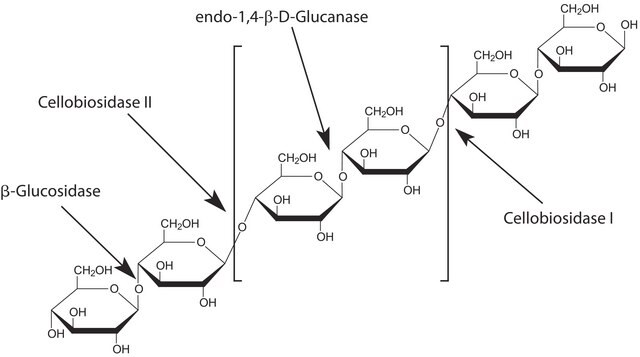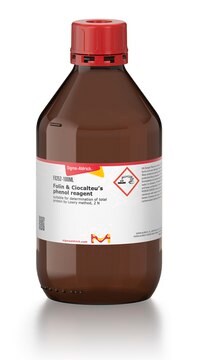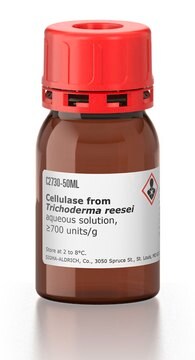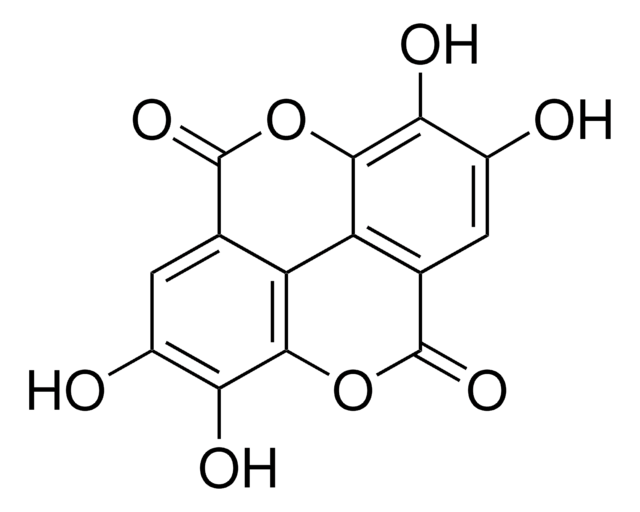42395
Tannase from Aspergillus ficuum
powder, white, ≥150 U/g
Sinónimos:
Tannin acyl Hydrolase
Iniciar sesiónpara Ver la Fijación de precios por contrato y de la organización
About This Item
Productos recomendados
origen biológico
Aspergillus sp. (A. ficuum)
Nivel de calidad
Formulario
powder
actividad específica
≥150 U/g
impurezas
25 mM potassium phosphate
250 mM NaCl
50% glycerol
color
white
temp. de almacenamiento
2-8°C
Descripción general
Tannase is an enzyme that is produced by several organisms such as plants, bacteria, fungi, and yeast. This enzyme is also found in plant sources such as tannin-rich vegetables, especially in the leaves, fruits, branches, and bark.
Aplicación
Tannase from Aspergillus ficuum has been used:
- as a standard to determine the tannase activity of bacterial isolates
- to study its effects on the inhibitory activity of tannic acid on biofilm formation
- to obtain Proanthocyanidins (PA) by enzymatic hydrolysis of grape skin and seeds
Acciones bioquímicas o fisiológicas
Tannase catalyzes the ester bonds located in complex tannins, gallo-tannins, and gallic acid esters, which results in the release of gallic acid. This enzyme can be used as a clarifying agent in the manufacture of beer, tea, wine, and juices and to treat tannin-polluting agricultural waste and industrial effluents.
Definición de unidad
1 U corresponds to the amount of enzyme which changes the absorbance at 310 nm by 1.0 per minute at pH 4.7 and 30°C (tannic acid as substrate, final volume 3 ml)
Palabra de señalización
Danger
Frases de peligro
Consejos de prudencia
Clasificaciones de peligro
Resp. Sens. 1
Código de clase de almacenamiento
11 - Combustible Solids
Clase de riesgo para el agua (WGK)
WGK 1
Punto de inflamabilidad (°F)
Not applicable
Punto de inflamabilidad (°C)
Not applicable
Equipo de protección personal
dust mask type N95 (US), Eyeshields, Faceshields, Gloves
Elija entre una de las versiones más recientes:
¿Ya tiene este producto?
Encuentre la documentación para los productos que ha comprado recientemente en la Biblioteca de documentos.
Los clientes también vieron
Arijit Jana et al.
Applied biochemistry and biotechnology, 167(5), 1254-1269 (2012-01-25)
Tannase production by newly isolated Penicillium purpurogenum PAF6 was investigated by 'one variable at a time' (OVAT) approach followed by response surface methodology (RSM). Tannin-rich plant residues were used as supporting solid substrate and sole carbon source and, among them
Jose Valdo Madeira et al.
Bioprocess and biosystems engineering, 35(3), 477-482 (2011-09-13)
The production of enzymes such as tannases and phytases by solid-state fermentation and their use in animal feed have become a subject of great interest. In the present work, Paecilomyces variotii was used to produce tannase and phytase simultaneously. Solid-state
Jose Valdo Madeira et al.
Bioresource technology, 102(15), 7343-7348 (2011-05-27)
In this work, we introduce a biological detoxification method that converts toxic waste from castor beans into animal feed material. This method simultaneously induces the production of tannase and phytase by Paecilomyces variotii; both enzymes have high levels of activity
Bhakti Bajpai et al.
Brazilian journal of microbiology : [publication of the Brazilian Society for Microbiology], 39(4), 708-711 (2008-10-01)
In a new approach to microbial gallic acid production by Aspergillus fischeri MTCC 150, 40gL(-1) of tannic acid was added in two installments during the bioconversion phase of the process (25gL(-1) and 15gL(-1) at 32 and 44h respectively). The optimum
Tadashi Takahashi et al.
Eukaryotic cell, 11(4), 507-517 (2012-01-31)
Loop-out-type recombination is a type of intrachromosomal recombination followed by the excision of a chromosomal region. The detailed mechanism underlying this recombination and the genes involved in loop-out recombination remain unknown. In the present study, we investigated the functions of
Nuestro equipo de científicos tiene experiencia en todas las áreas de investigación: Ciencias de la vida, Ciencia de los materiales, Síntesis química, Cromatografía, Analítica y muchas otras.
Póngase en contacto con el Servicio técnico











